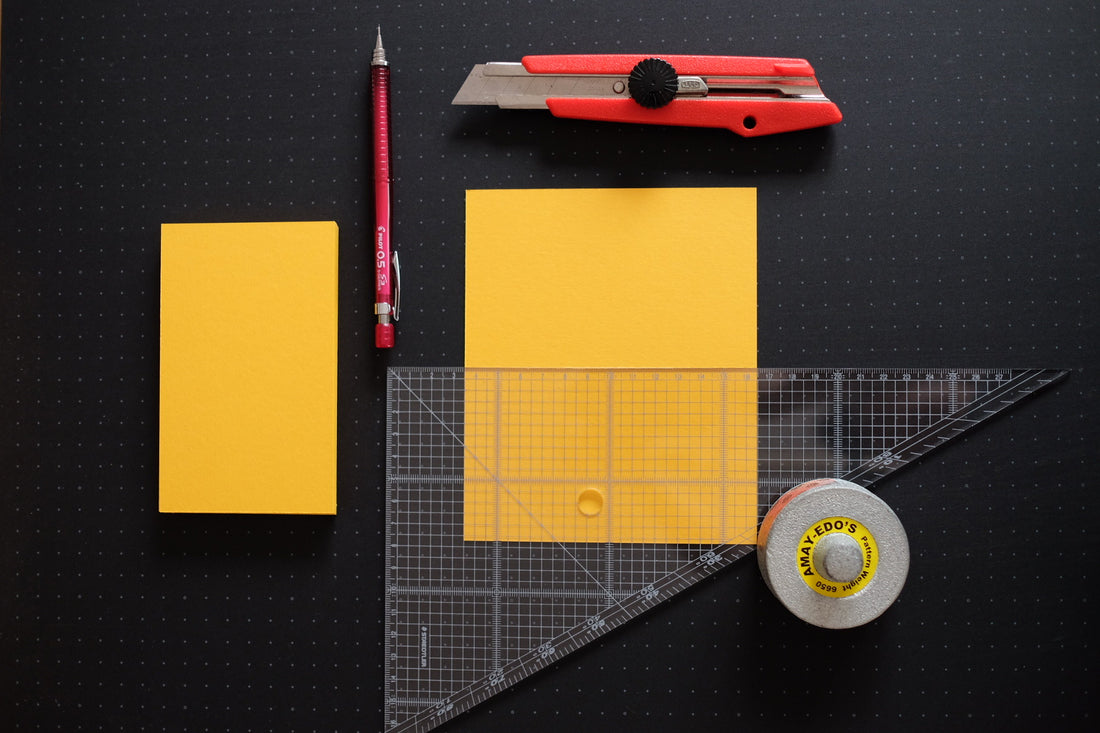
The Size Design Process
Continued from the previous post
2. The Size Design Process
HK:
Over the year, we have created about 30 products. The key point was that although the design concept and the paper were different, we applied the standard we designed of five sizes, S, M, L, XL, and W, to the products.
TH:
That’s true. Size design is one of the essential elements of our products.
HK:
First of all, the nature of you and I in letter writing is the complete opposite. I'm the person who, when I start to write, I go on for a long time and ends up using more than three sheets of letter paper. On the other hand, you usually just finish with a single word or a picture, don’t you?
TH:
Yes, I do. Even on message apps, I often just send stickers. But on the other hand, I also had a strong respect for people who write beautiful letters. That’s why I considered I could design stationery without being bound by existing forms. And then I thought, even if it ends up with one or two lines, that’s fine, no problem, because that’s who I am.
HK:
So we decided to make them with the idea that the tools should adapt to the person rather than the person adapting the tool!
TH:
Even clothes come in various sizes to suit your physique. The amount of words you write is as individual as your physique. Of course, unlike clothing sizes, the same writer can use different sizes for different moods or topics, though. Anyway, I first tried to create a dimension that felt right to me.
HK:
We were calling each other Long-san and Short-san Like ‘What do you think, Long-san?’ ‘How about you, Short-san?’ Anyway, In other words, one of our goals became to create a line-up that is widely used by the Long-san, Short-san, and in-between people. So, I first had you design a greeting card size for Short-sans.
TH:
In Japan, General greeting cards are based on the size of a postcard (148 x 100 mm) and fit just into a C6 size (162 x 114 mm) envelope. A7 size (105 x 74 mm) and business card size (91 x 55 mm) are commonly sold as smaller than postcard size. You can’t send those smaller cards through the post even if putting them in envelopes because the smallest size in the Japanese postal system is 140 x 90 mm. They are meant to be hand-delivered or attached to a gift. Then I thought, what if we made them based on the smallest size that can be sent by Japanese post? The result was the nandaka’s standard of S-size envelopes and cards, and the Home Series card set that uses this standard.

 Figure 2: Card sizes
Figure 2: Card sizesUntil the Home Series was completed, I focused on selecting the paper and coming up with ideas for the graphic, leaving the dimension entirely up to you. But when I wrote on the finished one, I was so excited that like it was made for me! I mean, unexpectedly, the size I had been waiting for.
TH:
That was surprising in a good way!
HK:
For people like me who tend to write long letters, I highly recommend it when you want to write a little letter to accompany a souvenir or a present. I always buy a card about the size of a business card and use it for that kind of thing. But I often gave up because there wasn’t enough space, although I wanted to write about the story when I found the souvenir or a little bit about what was going on. And then this S-size card! I was so happy to be able to put in all the things I had given up on at the time.
TH:
You look on the S size as being wider than a business card, don’t you? As opposed to me looking on it as a size narrower than a postcard.
HK:
We have different perspectives, but we both have in common that it’s a size we’ve never had before, but when we wrote it down, it was actually the size we wanted.
TH:
Yeah, each of us can clearly imagine our own way of using it. This is probably because I was conscious of not only the size but also the aspect ratio: the S size is a bit longer and narrower than a regular postcard.
HK:
Right. When I first saw it, I thought it was like the size of a smartphone screen.
TH:
When developing the sizes from S to M, L and XL, the emphasis was on avoiding a similar rectangle. While most paper products on the market have a similar shape with a constant aspect ratio as the size increases, in the case of nandaka, we designed the envelope to have a constant difference between width and height (except for the W). So the smaller the product, the more elongated it is, and the larger the product, the wider it is so that you can feel relaxed while writing long. I wanted to ensure that the feeling would change if the size changed even one step.
 Figure 3: Letter Paper sizes
Figure 3: Letter Paper sizes
HK:
For me, as a Long-san, the XL is perfect when I need a certain amount of writing but want to finish in just one letter-paper to make it concise. The XL is slightly smaller than A4, right?
TH:
Yes, it is. Our XL letter paper is slightly smaller than A4 (210 x 297 mm), and when folded in two, it is the same as our XL card. And when folded in three, it is the same as our W card, so it can be put in a W envelope. Anyway, we designed five sizes in this way.
HK:
We determined those five sizes and then created products representing each of them. When customers see the current product line-up, they are often surprised, like, ‘all of these products were made by nandaka?’ This is probably because these five sizes have distinctly different characters, and we assigned each product a different style. This is why the M-size Nail Polish Letter Paper and the L-size Yamagiwa Letter Paper have such different designs. In contrast, for the latest works, Birds Are Dinosaurs and Grid #01, we dared to make different sizes with the same style. This way, the difference in the impression by their sizes is reduced, so it’s easier for people to try sizes they think are slightly too big for them. It’s also great for Short-sans and Long-sans who enjoy writing letters together like us. We often use the Birds Are Dinosaurs S and L sizes to write our messages and send them in a single envelope.
TH:
Birds Are Dinosaurs and Grid #1 are now our two flagship products. More details are in the next chapter!
